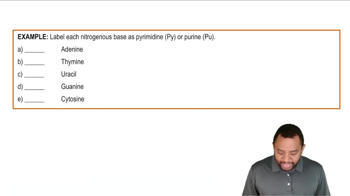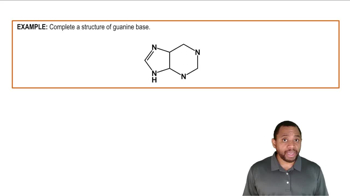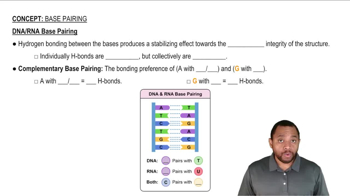Here are the essential concepts you must grasp in order to answer the question correctly.
Pyrimidines and Purines
Pyrimidines and purines are the two categories of nitrogenous bases found in nucleic acids. Pyrimidines, which include cytosine, thymine, and uracil, have a single six-membered ring structure. In contrast, purines, such as adenine and guanine, consist of a fused double-ring structure, which includes a six-membered and a five-membered ring. Understanding these classifications is essential for identifying the structure and function of nucleotides in DNA and RNA.
Recommended video:
Nitrogenous Bases Example 1
Guanine
Guanine is one of the five primary nucleobases in the genetic code and is classified as a purine. It plays a critical role in the structure of DNA and RNA, pairing with cytosine in DNA and RNA molecules. Guanine is also involved in various cellular processes, including energy transfer and signaling, due to its role in forming guanosine triphosphate (GTP). Recognizing guanine's classification helps in understanding its biochemical functions and interactions.
Recommended video:
Nitrogenous Bases Example 3
Base Pairing
Base pairing refers to the specific hydrogen bonding between nitrogenous bases in nucleic acids, which is fundamental to the structure of DNA and RNA. In DNA, adenine pairs with thymine, while guanine pairs with cytosine. This complementary pairing is crucial for the accurate replication and transcription of genetic information. Understanding base pairing is essential for grasping how genetic information is stored and transmitted in living organisms.
Recommended video:
 Verified step by step guidance
Verified step by step guidance


